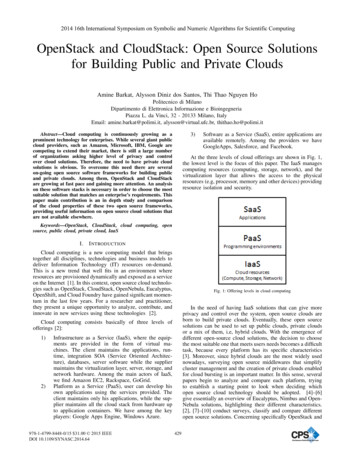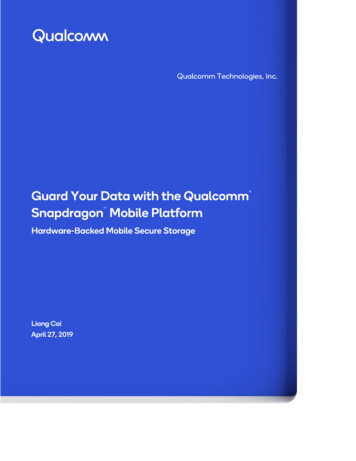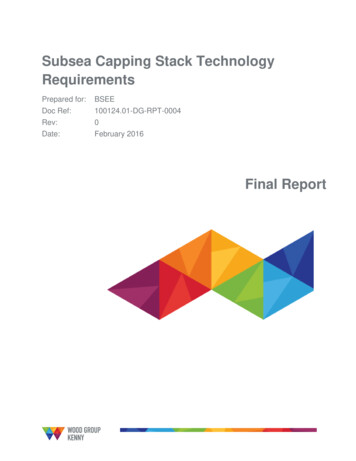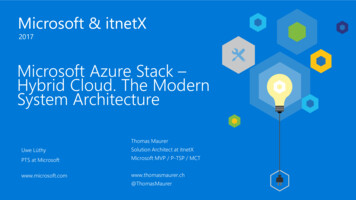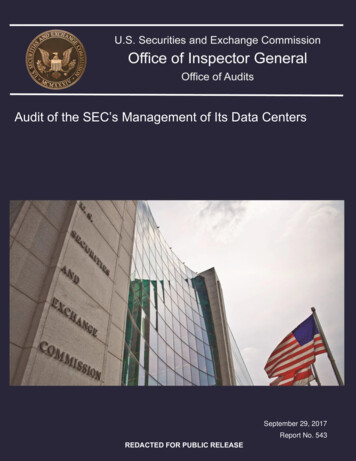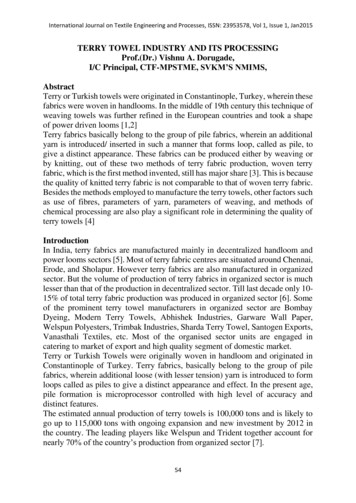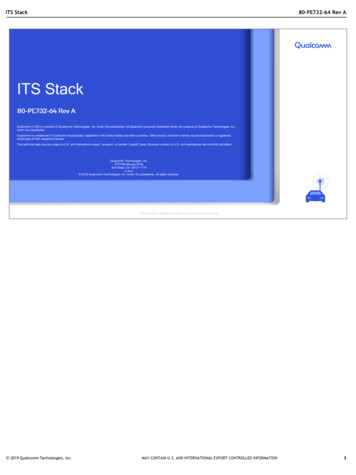
Transcription
80-PE732-64 Rev AITS StackITS StackQualcomm C-V2X is a product of Qualcomm Technologies, Inc. and/or its subsidiaries. All Qualcomm products mentioned herein are products of Qualcomm Technologies, Inc.and/or its subsidiaries.Qualcomm is a trademark of Qualcomm Incorporated, registered in the United States and other countries. Other product and brand names may be trademarks or registeredtrademarks of their respective owners.This technical data may be subject to U.S. and international export, re-export, or transfer (“export”) laws. Diversion contrary to U.S. and international law is strictly prohibited.Qualcomm Technologies, Inc.5775 Morehouse DriveSan Diego, CA 92121-1714U.S.A. 2019 Qualcomm Technologies, Inc. and/or its subsidiaries. All rights reserved. 2019 Qualcomm Technologies, Inc.MAY CONTAIN U.S. AND INTERNATIONAL EXPORT CONTROLLED INFORMATION1
80-PE732-64 Rev AITS StackObjectives2 2019 Qualcomm Technologies, Inc.MAY CONTAIN U.S. AND INTERNATIONAL EXPORT CONTROLLED INFORMATION2
80-PE732-64 Rev AITS StackITS Stack – Reference ArchitectureThe ITS stack reference architecturefollows the principles of the OSI model forlayered communication protocolsApplications LayerNetworking & transportation Layer OSI layers 3 & 4Security LayerAccess layer OSI layers 1 & 2Messages / Facilities LayerNetworking & Transportation LayerFacilities layer OSI layers 5, 6 & 7ITS stacks of different ITS standards arequite similarManagement LayerIt is extended to include an Applicationslayer for ITS applicationsAccess Layer3ITS access technologies layer covers various communication media and related protocols for the physical and data link layers. The accesstechnologies are not restricted to specific type of media, though most of the access technologies are based on wireless communication.The access technologies are used for communication inside of an ITS station (among its internal components) and for externalcommunication (for example with other ITS stations). For external communication, some of the ITS access technologies representcomplete, non-ITS specific communication systems (such as, GPRS, UMTS, WiMAX) that are regarded as 'logical links' over which ITSdata is transparently transported.The ITS network & transport layer comprises protocols for data delivery among ITS stations and from ITS stations to other network nodes,such as network nodes in the core network (e.g. the Internet). ITS network protocols particularly include the routing of data from source todestination through intermediate nodes and the efficient dissemination of data in geographical areas. ITS transport protocols provide theend-to-end delivery of data and, depending on requirements of ITS facilities and applications, additional services, such as reliable datatransfer, flow control and congestion avoidance. A particular protocol in the ITS network & transport layer is the Internet protocol IP version6 (IPv6). The usage of IPv6 includes the transmission of IPv6 packets over ITS network protocols, dynamic selection of ITS accesstechnologies and handover between them, as well as interoperability issues of IPv6 and IPv4.The ITS facilities layer provides a collection of functions to support ITS applications. The facilities provide data structures to store,aggregate and maintain data of different type and source (such as from vehicle sensors and from data received by means ofcommunication). As for communication, ITS facilities enable various types of addressing to applications, provide ITS-specific messagehandling and support establishment and maintenance of communication sessions. An important facility is the management of services,including discovery and download of services as software modules and their management in the ITS station.The ITS applications layer refers to ITS applications and use cases for road safety, traffic efficiency, infotainment and business.The two vertical protocol entities are: ITS management entity is responsible for configuration of an ITS station, cross-layer information exchange among the different layersand others tasks. ITS security entity provides security and privacy services, including secure messages at different layers of the communication stack,management of identities and security credentials, and aspects for secure platforms (firewalls, security gateway, tamper-proofhardware). 2019 Qualcomm Technologies, Inc.MAY CONTAIN U.S. AND INTERNATIONAL EXPORT CONTROLLED INFORMATION3
80-PE732-64 Rev AITS StackReuse establishedservice and app layers Already defined by automotive andstandards communities, e.g., ETSI,SAE International Developing abstraction layer tointerface with 3GPP lower layers (inconjunction with 5GAA)ApplicationsSafety and non-safetyMessage / Facilities layerIEEE / ETSI /ISO SecurityServicesUDP / TCPIPv6IEEE / ETSI / ISOTransport/NetworkReuse existing securityand transport layersReuse and adapt otherstandardsC-V2X Reuses Upper Layers Defined by the Automotive IndustryNon-IPV2X ProtocolPDCPRLCContinuous enhancementsto the radio/lower layersMAC Supports the ever-evolving V2X usecasesPHY3GPP scope Defined by ISO, ETSI, and IEEE1609 family4The automotive industry, through SAE International, ETSI, and IEEE, have doneconsiderable work in defining the Applications, the message/facilities later,security services and the Transport/networking layers. C-V2X leverages all of theexisting standards in these layers, and just replaces the PHY and the MAC(commonly called the Access layers) from 3GPP to provide the end to endsolution. 2019 Qualcomm Technologies, Inc.MAY CONTAIN U.S. AND INTERNATIONAL EXPORT CONTROLLED INFORMATION4
80-PE732-64 Rev AITS StackC-V2X – DSRC Protocol Stack ComparisonDSRCNon-SafetyApplicationsP2P CertificateDistributionServiceUDP / TCPIPv6ServicesNon-SafetyApplicationsP2P CertificateDistributionServiceMessageSubLayerCRL VerificationServiceWAVESecurityC-V2X (D2D/PC5 etworkingMessageSubLayerCRL DP / TCPWSMP,FASTIPv6IPv6Non-IPWAVE MAC(including lJ2735, SAEInternationalJ2945FamilyReuses otherstandards3GPP Rel-14V2X scopeRLCLower MAC PHYIEEE802.11pMACPHYProSe (D2D communications) stack is reused – Replacing WAVE MAC and Lower MAC PHY55Comparison of the DSRC and C-V2X implementation allows for reusing the upperlayers from DSRC products and replacing lower layers compliant with 3GPP specfor a C-V2X solution. 2019 Qualcomm Technologies, Inc.MAY CONTAIN U.S. AND INTERNATIONAL EXPORT CONTROLLED INFORMATION5
80-PE732-64 Rev AITS StackEvolution of the V2X Stack (EU Version)C-V2X (D2D/PC5 based)ITS (ITS-G5 ehaviorreportingITSsecurity&ManagementManagement ies LayerUDP / TCPBTPTransportIPv6GeonetworkingSecurityITS-G5 Access LayerServicesITS-G5 LLCITS-G5 MAC802.11 PHYITSsecurityTS 102731, TS102940,.SafetyApplicationsFacilities LayerUDP / esNon-IPETSI EN302 663, V2XProtocolPDCPETSI-ITSStandardsfamiliesReuses otherstandards3GPP Rel-14V2X scopeRLCMACPHY ProSe (D2D communications) stack is reused – Replacing WAVE MAC ITS-G5 PHY MAC (based on 802.11-OCB/11p) ETSI-ITS upper layer standards are reused and supported66The same approach is taken for EU version of the WAVE stack. Replacing theAccess layer based on ITS-G5 with 3GPP based C-V2X stack. 2019 Qualcomm Technologies, Inc.MAY CONTAIN U.S. AND INTERNATIONAL EXPORT CONTROLLED INFORMATION6
80-PE732-64 Rev AITS Stack802.11 and IEEE 1609.X SpecsQuick OverviewApplicationBased on 802.11 PHY Contention based transmission (CSMA/CA) Limits CapacityUses part of 802.11 MAC and LLC Uses MAC Data Frame structure of a MAC-PDU dot11OCBActivated true, See IEEE 1609.4-2016 Section 41, 802.11-2016 Section 11.21 Specific LLC code to identify DSRC traffic 0x88DC for WSMP, 0x86DD for IPv6, IEEE 1609.3-2016 Section 5.2.3Security(1609.2)SAE International J2735ETSI 302 637-2, 302 637-3UDP/TCPIPv6Uses IEEE 1609.4, 1609.3 upper MAC IEEE 1609.3 specifies WAVE message formats IEEE 1609.12 lists all assigned PSIDs IEEE 1609.2 specifies security proceduresWSMP(1609.3)LLC(1609.3, 802.2)WAVE/MAC(802.11 1609.4)SAE International J2735ETSI 302 637-2 (CAM), Co-operative Awareness MessagesPHY(802.11)ETSI 302 637-3 (DENM), Decentralized Environment Notification msgs.7This slide lists all the specifications that have been developed and implementedfor providing functionality at each layer.WAVE stands for Wireless Access in Vehicular Environment and comprises theWSMP (Wireless services messaging protocol) based on IEEE 1609.3 standard,the SAE International J2735 (Society of Automotive engineers J2735 for messagedictionary), the Security based on IEEE 1609.2.The corresponding ETSI spec versions are also listed for comparison. 2019 Qualcomm Technologies, Inc.MAY CONTAIN U.S. AND INTERNATIONAL EXPORT CONTROLLED INFORMATION7
80-PE732-64 Rev AITS StackCommon ITS MessagesSAE International MessageETSI ITS MessageBasic Safety Message (BSM)Co-operative Awareness Message (CAM) /Decentralized Environment Notification Message(DENM)Emergency Vehicle Alert (EVA)DENMSignal Phase & Timing(SPaT / MAP)SameTraveller Information Message (TIM)DENMCurve Speed Warning(CSW - special TIM)n/a8SAE International and ETSI have different names for certain ITS messages,though their function may be the same. For example, safety messages in SAEInternational are called BSMs, whereas in ETSI they are referred as CAM orDENM.The others are also listed for comparison. 2019 Qualcomm Technologies, Inc.MAY CONTAIN U.S. AND INTERNATIONAL EXPORT CONTROLLED INFORMATION8
80-PE732-64 Rev AITS StackSAE International J2735 Messages: ExamplesRelevant SAE InternationalMessageFCW (Forward Collision Warning)BSMEEBL (electronic Emergency Brake Light)BSMEmergency VehicleBSM – part II (Special Vehicle)Weather WarningTIMIn-Vehicle SignageTIMRoad WorkRSA, TIMVRU / PSM (Pedestrian Safety)PSMGreen SpeedBSM, RSA, PSM, MAPIMA (Intersection Movement Assist)BSM, RSA, PSM, MAP, TIMBSW/LCW(Blind Spot Warning, Lane ChangeWarning)BSMLTA ( Left Turn Assist)BSMApplicationSAE International J2945/1, J3161/1 BSM’sSAE International 3)LLCMACPHY9Various warnings and informational messages can be realized using the availableSAE International messages as explained earlier. The table above lists some ofthe example scenarios that can be realized by utilizing one or more of the BSMs,TIMs, MAP, etc. 2019 Qualcomm Technologies, Inc.MAY CONTAIN U.S. AND INTERNATIONAL EXPORT CONTROLLED INFORMATION9
80-PE732-64 Rev AITS StackETSI CAM/DENM Messages: ExamplesLCRW *(Forward Collision)CAM: Basic HFLCRW (EEBL)CAM: Basic HF LFEmergency VehicleCAM: Basic HF SpecialWeather WarningDENMIn-Vehicle SignageDENM: Basic HF(RSU)Road WorkDENM, seeTS103.301 andTS19321GLOSA (green light optimal speed advisory)SPAT MapICRW (Intersection Collision)CAM: Basic HF LFBSW/LCW(Blind Spot Warning, Lane Change Warning)CAM: Basic HF LFLTA ( Left Turn Assist)CAM: Basic HF LFApplicationETSI EN 302 637-2, 302 637-3Basic Transport ProtocolETSI EN 302 646-5GeonetworkingETSI EN 302 636-3DCCTS102 687Relevant ETSI MessageSecurityScenarioMACPhy*LCRW Longitudinal Collision Risk WarningHF – High FrequencyLF - Low Frequency10Various warnings and informational messages can be realized using the availableETSI messages as explained earlier. The table above lists some of the examplescenarios that can be realized by utilizing one or more of the CAM, DENM, SPAT,MAP, etc. 2019 Qualcomm Technologies, Inc.MAY CONTAIN U.S. AND INTERNATIONAL EXPORT CONTROLLED INFORMATION10
80-PE732-64 Rev AITS StackBasic Safety Message Components, SAE International J2945/1, J3161/1Part 1: Contains Core data elements [ 40 bytes] Temporary ID Sequence # (AKA “msgCnt) secMark ( Timestamp at the location fix) Position, Velocity / Heading, acceleration Vehicle Length/Width Brake System Status (Braking, ABS, TCS, SCS) Transmitted 10 times a second unless congestion control is invokedPart II: Extension Contains variable set of data elements which are optional Transmitted less frequently Vehicle Safety Extension Critical Event Flags [13 bits] Vehicle Light Status [9 bits] Path Prediction [25 bits] Radius Confidence Path History Points [0 to 120 Bytes]11BSM comprises 2 parts, each containing different data elements and extensionfields.BSM is technically extensible via optional fields and regional extensions.However J2945/1 has, for the time-being, “locked down” the content.Part 1 is sent once every 100 ms whereas Part 2 is sent less frequently. 2019 Qualcomm Technologies, Inc.MAY CONTAIN U.S. AND INTERNATIONAL EXPORT CONTROLLED INFORMATION11
80-PE732-64 Rev AITS StackGlobal ITS-AID/PSID Assigned Maps to 3GPP L2ETSI CAM 0p24 , 0x24 DENM 0p25 , 0x25SAE International J2735 (specifies in SAEInternational J2945/0) BSM - V2V safety and awareness 0p20, 0x20 BSM – Tracked vehicle safety and awareness 0p21, 0x21 Tracked vehicles are railroad trains, light trucks, etc. PSM/VRU – Vulnerable road users safety 0p27, 0x27 RTCM – Diff. correction, uncompressed 0p80-00, 0x80 RTCM – Diff. corrections, compressed 0p80-01, 0x81 SPAT, MAP – Intersection safety and awareness 0p80-02,0x82 TIM – Traveler info and roadside signage 0p80-03, 0x83 PDM, PVD – mobile probe exchange 0p80-04, 0x84 EVA – Emergency and erratic vehicle 0p80-05, 0x85PS-ID – Provider Service IdentifierITS-AID – Intelligent Transportations Systems Application Identifier12 2019 Qualcomm Technologies, Inc.MAY CONTAIN U.S. AND INTERNATIONAL EXPORT CONTROLLED INFORMATION12
80-PE732-64 Rev AITS StackMessage EncodingMessage type Identified by PSID or ITS Application ID (ISO ETSI) Standardspecifies encoding of each application IDUP
ICRW (Intersection Collision) CAM: Basic HF LF BSW/LCW (Blind Spot Warning, Lane Change Warning) CAM: Basic HF LF LTA ( Left Turn Assist) CAM: Basic HF LF Basic Transport Protocol ETSI EN 302 646-5 ETSI EN 302 637-2, 302 637-3 Geonetworking ETSI EN 302 636-3 Application CC 7 MAC Phy *LCRW Longitudinal Collision Risk Warning HF .
